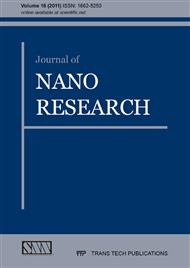p.21
p.29
p.37
p.43
p.49
p.55
p.63
p.69
p.77
Oscillating Velocity and Enhanced Diffusivity of Nanosystems from a New Quantum Transport Model
Abstract:
The generalizations of the Drude model describe classically the most important quantities referred to transport phenomena, i.e the velocity correlation functions, the mean square deviation of position and the diffusion coefficient. The quantum effects, appearing in systems at nano-dimensions, require a quantum treatment of the previous models. I have presented a new ‘time-domain’ quantum mechanical model for transport in nanosystems, which comprehends the oscillator strength weights; this model demonstrates high generality and good application perspectives also in the study of ions, solutions, and in nano-bio-systems. This quantum mechanical extension allows to test the diffusion in nanostructured materials for biological, medical and nanopiezotronic devices. The theoretical elaboration of experimental data shows the interesting presence of an initial oscillating behaviour in velocity and an enhanced initial diffusivity, offering considerable informations for the experimental researchers.
Info:
Periodical:
Pages:
49-54
Citation:
Online since:
January 2012
Authors:
Price:
Сopyright:
© 2011 Trans Tech Publications Ltd. All Rights Reserved
Share:
Citation:


